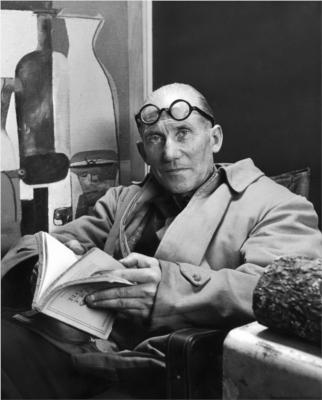
Le Corbusier’s Le Modular system helped to further enhance the quality of spaces by dimensioning the spaces based on the human ergonomics and every day based activities. Though this system helps us to visualize the ergonomics of the space, it does not work for every space criteria as well. Most architects, Richard Meir for instance used the the Modular system as a dimensioning system and then decided to not use it later in his life simply because he felt that it does not work for all criteria needed for certain spaces.
What Le Modular does is that it always relates back to the human scale which showcases the main purpose of the system. It is based on a 6 foot policeman and of which the modular’s dimension is the right and perfect height for scale references in architecture. There are certain aspects of the Modular system which are very important as it were and really having something to do with human scale and when you think of Le Corbusier’s work where buildings are not just experienced through photographs and you will just be amazed on the intimacy of it. It is the way in which the moulding of that space and its relationship to the human scale and light is made. So, it is the quality of light and the human scale, these aspects that are the richness of Le Corbusier’s work. It is also about the experience of how you move through spaces and see landscapes in a unique setting and the experience of being there physically.
In relation to our site at Terengganu, Pura Tanjung Sabtu also adapts to a system where ergonomics are measured for dimensioning the quality of spaces. However, the system differs to what is practiced in the west side of the world. As a southeast Asian, we also adapt to a system similar to the modular system however it differs based on the methodology of the system. In the west, the westeners often use the modular man or the policeman as a reference to the scale they use in their buildings, but in the east we used the length and span of our arm, hands , fist and even fingers to produce especially intricate wood carvings.Besides that, the standard height of the modular man set by Le Corbusier is 6 feet following the most common height of men in the western side of the world. In the east however, most men are usually shorter and not reaching to the standards set by Le Corbusier’s le Modular. This shows the significant difference in ergonomics divided by different people around the word.
Furthermore, Malay houses are also mostly built using timber construction and the spaces are designed for specific purposes. For instance, the entrance to a Malay home is often shorter in height so that the visitor has to have a sense of bowing to the owner and symbolizing respect. Having this sort of adat resam further questions the reliability of the Modular system being the perfect system that every other countries in the word to follow as a guide. Just like what Richard Meir mentioned, the system does not work for all criteria needed for certain or specific spaces.
In conclusion, It goes without saying that things that are in proportion to one another are naturally more pleasing to the eye. But what's really important is that the Modulor puts the human form back at the centre of design. In the present architectural climate of post-modern free-for-all, driven by computer processors and but human proportions are out of the picture. Maybe this is the result of an understandable discomfort with the idealisation of the human body. But we should overcome that discomfort to obtain the magical comfort of inhabiting spaces that we know were designed with our forms in mind.
Comments
Post a Comment